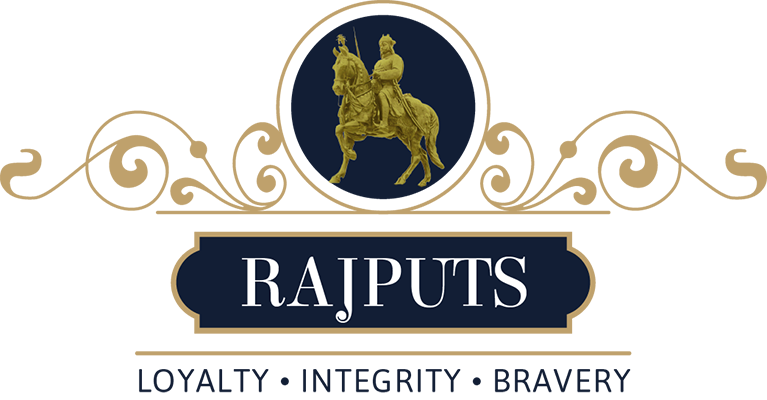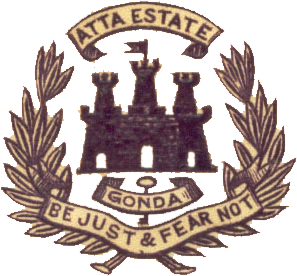Present Head
Raja DEVI BAKSH SINGH, was the last Raja of Gonda, the property being given to the Zamindar of Balrampur after 1857.
History
The ancestor of the Bisen Dynasty of Gonda, Bhinga, Kalakankar etc was Raja Prithvi Mall of Majhauli in Gorakhpur. Gonda was founded by Man Mall, the first to use the surname of Singh, who was given the title of Raja in 1618 by the Mughal Emperor. He was also the ancestor of the Rulers of Bhinga and Mankapur.
Genealogy
- Raja PRITHVI MALL, Raja of Majhauli in Gorakhpur, married and had issue.
- Raja Pratap MALL (qv)
- Raja Hom MALL, ancestor of the Rajas of Kalakankar.
- Raja PRATAP MALL, Raja of Majhauli
- Raja SHAH MALL, Raja of Majhauli
- Raja KUSUM MALL, Raja of Majhauli
- Raja MAN SINGH, Raja of Majhauli then of Gonda, changed his surname to Singh, married and had issue (continued below)
- Raja MAN SINGH, 1st Raja of Gonda 1618/-, in 1618 he presented to the Mughal Emperor a fine elephant at Ajmer and in reward obtained the title of Raja.
- Raja LAKSHMAN SINGH, 2nd Raja of Gonda
- Raja NIRVAHAN SINGH, 3rd Raja of Gonda
- Raja AMAR SINGH, 4th Raja of Gonda
- Raja RAM SINGH, 5th Raja of Gonda 1665/1693, in 1665, Raja Ram Singh, came to the throne and his reign marked a period of prosperity for the clan. He promptly carried a war with the Janwars and destroyed their fort at Bhatpuri around 1665 and succeeded in ejecting them from that place. He then turned his attention to the west and drove out the Raikwars from the lowlands, annexing 74 villages which were formed into a new pargana of Paharapur. He married and had issue. He died .
- Raja Dutt Singh (qv)
- Raja Bhawani Singh, he received the estate of Bhinga from his brother.
- Raja DUTT SINGH, 6th Raja of Gonda 1693/- , he rose to be the most powerful of the chieftains north of the Ghaghara. His first expedition is said to have been against the Pathans of Bahraich in revenge for an outrage of a Brahmana women. He then turned his arms southwards and with the help of the Pathans of Utraula he conquered and annexed Paraspur and Ata and thus the boundary of the Bisen was fixed to the south of the town of Paraspur. The extent of his dominions was the whole of the Paraspur Gonda, Digsir Mahadeva and part of Gunwarich. After an insult by Alawal Khan an Afghan of Bahraich, the Raja of Gonda refused to pay revenue, and Alawal Khan was sent with a big force to Gonda. Crossing the river Ghaghara at Paska he was joined by the Kalhans, with whose aid he stormed the Paska fort and then defeated a Brahman contingent at Malauna. Advancing towards Gonda, after a short delay the Raja collected his forces and a fierce encounter took place at Sarbhangpur in pargana Paharapur, Alawal khan was killed and the Nawab's forces fled. Raja Dutt Singh regained his position, though not for long, shortly afterwards, Gonda was besieged by a second army but the siege was eventually raised on the arrival of a large force of Bisen of Ramapur in the north of the pargana. The Raja then came to terms with the government and agreed to pay revenue, but his territories were made into a separate jurisdiction, independent of the Nazim of Baharaich. This arrangement did not curtail Datt Singh's power but rather his power increased. He managed to place his brother Bhawani Singh in possession of the Janwar estate of Bhinga which henceforth was held by the Bisens . He also seized the Bandhalgoti rai of Mankapur and gave it to his younger son, Azmat Singh who was still an infant. So great was his influence that all the chieftains north of Ghaghara, acknowledged him as suzerain and brought their forces into the field at his command, between the Ghaghara and the Kuwana, the Bisen Raja had no rival, and power remained in the hands of his descendants till the advent of British rule. He married and had issue.
- Raja Udit Singh (qv)
- Raja Ajmat Singh, he received the estate of Mankapur from his father.
- Raja UDIT SINGH, 7th Raja of Gonda, like his father he retained the engagement of the whole of his estate as a separate revenue division under the Lucknow government. He was more given to religion than to war and made several expeditions to Mathura and other places of pilgrimage. He is remembered as the builder of the temples on the artificial island and lake between the town of Gonda and the station. He married and had issue.
- Raja Mangal Singh (qv)
- Kanwar Pahlwan Singh, married and had issue.
- Kanwar (name unknown) Singh, married and had issue.
- Raja Guman Singh (qv)
- Kunwar Daljit Singh, married and had issue.
- Raja Devi Baksh Singh (qv)
- Kanwar Hindupat Singh
- Kanwar (name unknown) Singh, married and had issue.
- Raja MANGAL SINGH, 8th Raja of Gonda, his reign was very short, he had been invited to arbitrate between the two sons of the Raja of Bansi and while absent in Basti was murdered by Zalim Singh, a Surajbansi of Amarha, a partisan of one of the claimants. He married a Kalhans lady of Paraspur, and had issue.
- Raja Sheo Prasad Singh (qv)
- Maharani Ser Kunwar, married (as his first wife), Umara-i-Uzzam Maharaja Mahendra Aniruddh Singh of Bhadawar.
- Raja SHEO PRASAD SINGH, 9th Raja of Gonda, he at once marched into Amorha and laid the pargana waste and annexed the same to his own dominions. He was a peaceful and prudent prince and retained the whole of his ancestral possessions.
- Raja Jai Singh (qv)
- Raja JAI SINGH, 10th Raja of Gonda, he refused to pay the customary tribute and incurred the wrath of the authorities as he interfered in the work of an English officer who had been sent to assist the nazim in the collection of the revenue and who had established salt and indigo works at Gauhani (in Digsir), he resented violation of his territories as a personal insult and took up arms against the Avadh government.The result was a short and decisive battle on the banks of the river Terhi, in which Jai Singh was defeated. He fled to the hills, where he died . He married (amongst others), Rani Phul Kanwar.
- Raja GUMAN SINGH, 11th Raja of Gonda -/1836, his uncle Hindupat Singh objected to his adoption and compelled Rani Phul Kanwar to flee and while crossing the Bisuhi, she was murdered by him, who also endeavored though unsuccessfully to secure the person of Guman Singh. After a short time the latter was induced to leave his hiding place at Ayodhya and went to Gonda, where his life was preserved through the vigilance of the Pandes. Eventually, after several attempts had been made on the life of Guman Singh ,the Pandes attacked Hindupat Singh and murdered him and his whole family. Though Guman Singh became Raja, yet on account of his youth and the disturbences that attended his accession, the revenue officials stepped in and Nirmal Das brother of the famous minister Tikait Rai, who was then at Bahraich, marched with a large force to Gonda and took the estate under his direct management. He seized Guman Singh and sent him in custody to Lucknow. There he remained in confinement till he invited the interest of the celebrated Mahant Jagjiwan Das of Kotwa in Barabanki, who was the founder of the Sattnami sect and who was a person of great influence. It was his intercession, which secured the release of the Raja. He subsequently gave him in marriage his daughter, Bhagwant Kunwar, a lady of great ability. Rani Bhagwant Kunwar survived the whole of her husband's family. Guman Singh returned to Gonda and was allowed for his subsistence 32 villages and a cash assignment in the revenue. He lived on good terms with the officials and from time to time added the engagement of other villages to those which he held in Nankar. When he died in , he left a large estate and considerable wealth but with no son. A short interregnum ensued,and the Pandes favoured the cause of Sanumam Singh, son of Madho Singh of Mahnon. However eventually the widow of Saif-ud-daula, who was then nazim, placed on the throne Devi Baksh Singh, son of Daljeet Singh, the younger brother of the late Raja. He married Rani Bhagwant Kaur. He died sp 1836. INTERREGNUM 1836/183x
- Raja DEVI BAKSH SINGH, 12th Raja of Gonda 183x/1857, this prudent and active prince built a strong fort at Jigna in the east of the Pargana, from where he managed his estate. He increased his property rapidly, disallowing any interference between him and the cultivators of his land, by marrying a daughter of the Raja of Bhadawar, he formed an alliance with one of the highest Rajput families in northern India. He fought alongside Begum Hazrat Mahal of Oudh against the British forces and reportedly went to Nepal with the Begum, where he died at an unknown date. He married the daughter of the Raja of Bhadawar, and may have had issue.
Rani Phul Kanwar, for some time managed to exercise her authority over the domain, later on she adopted Guman Singh, (?grand son of Pahlwan Singh.)

